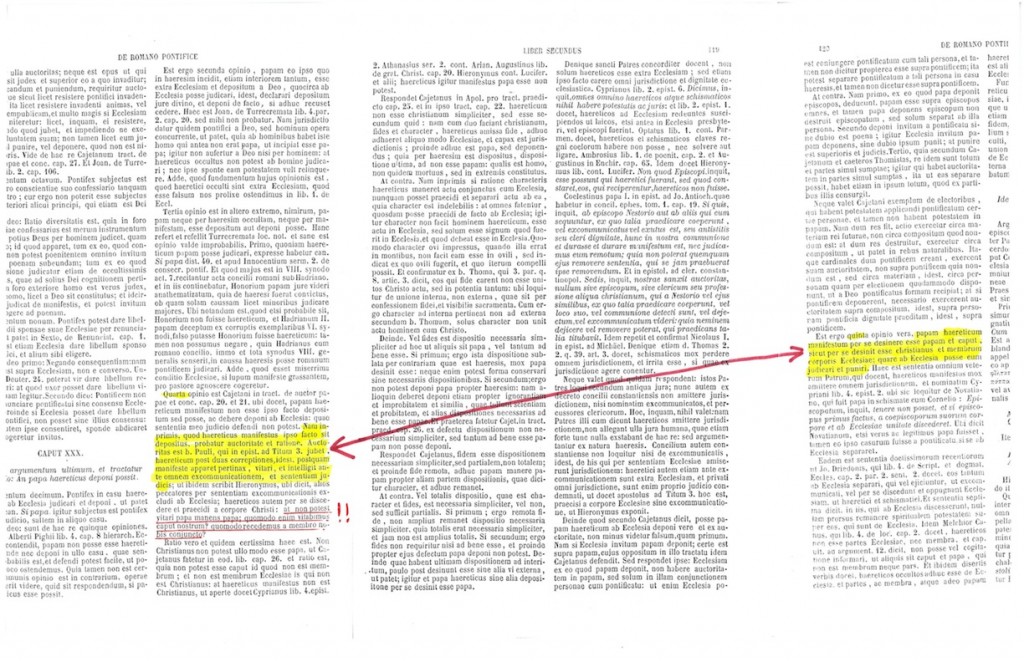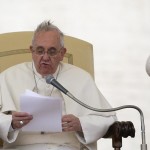In his April 2014 Catholic Family News article “Bellarmine and Suarez on the Question of a Heretic Pope,” Robert Siscoe presents the following passage from Bellarmine’s De Romano Pontifice, putting an ellipsis (three dots indicating omitted material) in the middle:
“[I]n the first place” wrote Bellarmine, “it is proven with arguments from authority and from reason that the manifest heretic is ‘ipso facto’ deposed. The argument from authority is based on Saint Paul, who orders that the heretic be avoided after two warnings, that is, after showing himself to be manifestly obstinate – which means before any excommunication or judicial sentence (…) Therefore… the Pope who is manifestly a heretic ceases by himself to be Pope and head, in the same way as he ceases to be a Christian and a member of the body of the Church; and for this reason he can be judged and punished by the Church.” (6)
On the accompanying scan of the original reproduced above, note the two passages Siscoe telescoped together with his little ellipsis. You don’t have to be a Latinist to figure out that two passages with several intervening columns in small print might just possibly refer to two different issues. But this doesn’t prevent Mr. Siscoe from immediately asking us to draw the following conclusion:
“As we can see, according to Bellarmine a manifest heretic is one who remains obstinate ‘after two warnings’. Such manifest obstinancy reveals pertinacity in the will, which is necessary for a materially heretical statement to qualify as formal heresy in the external forum. By remaining obstinate after a solemn and public warning, the Pope would, in a sense, pass judgment upon himself, thereby showing himself to be a heretic properly so-called. It is for this reason, according to Bellarmine, that the Pope – ‘who judges all and is judged by no one’ – can himself be judged and punished by the Church.”
Oh really? What is actually going on is this:
The first of Siscoe’s two telescoped passages concerns what Bellarmine calls the fourth opinion on a heretical pope, that of Cajetan, who maintained that a heretical pope was not automatically deposed, but had to be deposed by the Church.
Bellarmine argues at great length against Cajetan throughout the intervening columns, saying that no, this couldn’t possibly be the case, because a heretic automatically puts himself out of the Church. Bellarmine starts his argument for this position by alluding to the following passage from St. Paul: “A man that is a heretic, after the first and second admonition, avoid: Knowing that he, that is such a one, is subverted, and sinneth, being condemned by his own judgement.” (Titus 3:10–11)
The second of Siscoe’s telescoped passages is from what Bellarmine calls the fifth opinion, the one that Bellarmine himself defends: A pope who is a manifest heretic automatically ceases to be pope.
By telescoping the two passages with an ellipsis, Siscoe hopes to make it appear that Bellarmine required two warnings to a heretical pope as a necessary condition for concluding a pope had lost his office. Not only that, but Siscoe ups the ante to what he calls “a solemn and public warning.”
But Bellarmine did no such thing.
First, the saint was merely following a standard convention in theological argument: Use a scripture passage as a first proof wherever possible.
So Bellarmine alluded to Titus 3:10-11 simply to establish the major premise for his argument: Heresy is a type of self-judgement that puts you (and by extension, a heretical pope) outside the Church. In fact, Catholic commentaries like Challoner-Haydock-Gnass in the 1935 Douay Bible House edition of the New Testament make the same general point about this passage:
“By his own judgment. Other offenders are judged, and cast out of the Church, by the sentence of the pastors of the same Church. Heretics, more unhappy, run out of the Church of their own accord, and by doing so, give judgment and sentence against their own souls.” (p. 732)
“But you can’t avoid a pope who remains pope; for how can we avoid our head?” Bellarmine asks (and Siscoe omits), so how do you solve the problem? Having used Titus 3 as his launching pad, the saint says nothing more about correptiones (“admonitions” or “warnings”) as he proceeds at great length to slice and dice Cajetan.
Second, in the fifth opinion, Bellarmine’s own, he likewise says nothing whatsoever about correptiones for a heretical pope. If they were such a big deal for him, Bellarmine would have defined the term very, very precisely for us, and exhaustively outlined the manner in which they were to be delivered to a heretical pope.
Instead, zip, nada, nothing.
So Mr. Siscoe’s argument on this point, like so many R&R critiques of the sedevacantist position, is just more windbaggery from a writer who has no idea what he’s talking about.
— Rev. Anthony Cekada
May 8, 2014
www.fathercekada.com


2 Trackbacks/Pingbacks
[…] Robert Siscoe juega Rayuela con San Roberto Belarmino […]
[…] Robert Siscoe juega con San Roberto Belarmino […]